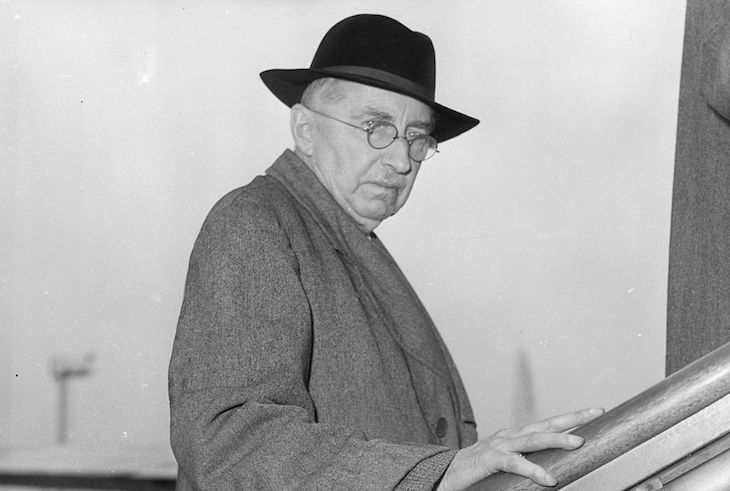‘Publitical’ is a neologism worth avoiding. Bill Goldstein uses it to describe T.S. Eliot’s activities when launching and promoting his quarterly review of literature, the Criterion, which had its first issue in October 1922. Eliot wanted an eminent French author as a contributor: ‘the only name worth getting is Proust’, he told Ezra Pound. As the founding editor of the New York Times books website, Goldstein is attuned to cultural fashions, publicity drives and the politicking of literary factions. And so he makes a painfully reductive explanation of Eliot’s remark: ‘The importance of Proust was publitical above all.’
1922 was the publication year of P.G. Wodehouse’s The Clicking of Cuthbert and of Wittgenstein’s Tractatus Logico-Philosophus. It was the foundation year of the Laugh-a-Gram cartoon film company (proprietor, Walt Disney). But there was nothing ‘publitical’ about Wodehouse or Wittgenstein, and so Goldstein turns his focus on Eliot (who finished and published The Waste Land), D.H. Lawrence (who wrote a novel set in Australia, while living in a small town in New South Wales), E.M. Forster (who overcame writer’s block and began his last novel), and Virginia Woolf (who wrote a short story, ‘Mrs Dalloway in Bond Street’, which she expanded into a wonderful novel). As Kangaroo was published in 1923, A Passage to India in 1924 and Mrs Dalloway in 1925, the reality behind Goldstein’s chronological arrangement seems weak.
Goldstein is an enthusiast for literature with the right measure of self-belief. He crackles with excitement about the making of books and the creating of literary reputations. His admiration for his four chief protagonists gives a nice temper to his own book: there is no one whom he wants to show up or do down. Einstein and Patrick Hennessy, scientist and historian, both took as their motto: ‘Never lose a holy curiosity.’ But although Goldstein reveres his quartet, his inquisitiveness is neither discriminating nor hallowed. He gives his readers a trudging chronicle, week by week, sometimes even day by day, of his protagonists’ activities and ideas during 1922. His purpose is to convey the tensions, fumbling, frustration, arousal and joyous climax of creativity. But the foreplay is so fidgety and inconclusive that the reader is left panting for a cup of cocoa.
Goldstein is a man for the microscope rather than the telescope. His readers are given such close and tiny details that the big vision is lost. There is nothing interesting in Eliot’s decision to wear black tie at a dinner of Lady Rothermere’s or in the stewed pears offered to Lawrence for breakfast. Inordinate quotation from his subjects’ letters and diaries makes for choppy, disjointed reading and peppers Goldstein’s pages with too many inverted commas. He seems remote in his understanding of Woolf as a woman, and at his most sympathetic in writing of Forster’s doubts and anxiety. Yet Goldstein’s account of Kangaroo will be new and appetising to most readers. If only he had written more about this half-forgotten novel, and less about people’s ailments and squabbles.
He puts Eliot, Lawrence and Woolf, if not so much Forster, into a mental landscape of postwar trauma. The scale of death from the war of 1914–18 and the subsequent influenza epidemic left its survivors grieving and haunted: memories of the past were encased in everybody’s present thoughts. Goldstein reiterates:
‘Mrs Dalloway in Bond Street’, Kangaroo and The Waste Land all declared the glaring contradiction of 1922: the war was over, but had not ended.
This is too trite a theme to bear the weight of significance that is piled on it in The World Broke in Two.
The title is one of the best points in Goldstein’s book. ‘The world broke in two in 1922 or thereabouts,’ Willa Cather wrote in 1936 of the year when Joyce published Ulysses and Eliot The Waste Land. The phrase looks catchy on the book cover, but Goldstein is ungrateful to Cather. In the modernist ascendancy of 1922, ‘the form of storytelling she prized, and excelled at, was no longer of signal importance’, he says on the first page of his book. ‘She was the relic of an old literature, the value of which had not been preserved against the new literature that Joyce and Eliot represented.’
This is the New York literary publitician talking like a commodity dealer taking a short-term position. Cather’s novel of 1922, One of Ours, is a lopsided, risk-taking triumph with flaws that increase its fascination: it would be acclaimed for its war writing if she had been a man. Her next novel, A Lost Lady (1923) is a marvel of emotional richness: Madame Bovary set in a small American community called Sweet Water; little known in England, but unforgettable to anyone who has read it. Both novels leave A Passage to India bowled middle-stump. Goldstein’s dismissal of Cather as démodée gives an early warning of what is wrong with his over-researched, unreflective and lustreless book.






Comments